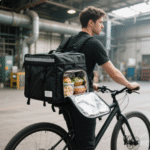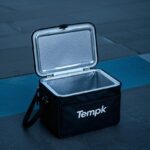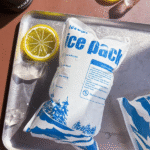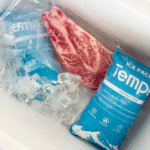How Cold Chain Pharma Logistics Keeps Medicine Safe in 2025?
As the pharmaceutical industry races towards personalised therapies and biologics, cold chain pharma logistics has become the backbone of patient safety. Temperature‑controlled logistics already swallow 23 % of pharmaceutical transportation budgets, acima de 18 % em 2020, and the global cold‑chain logistics market reached NÓS $18.61 bilhão em 2024. With new regulatory deadlines approaching and advances such as blockchain sensors, AI‑powered route optimisation and sustainable packaging, understanding the cold chain is essential for anyone handling modern medicines.
-
Key challenges in cold chain logistics – why supply chain complexity, temperature excursions and talent gaps create risk.
-
Technology innovations – from IoT sensors and blockchain to AI routing, predictive shelf‑life modelling and cryogenic containers.
-
Sustainability and green logistics – how solar storage, phase‑change materials and reusable packaging reduce carbon footprintspharmaadvancement.com.
-
Regulatory and compliance updates for 2025 – including DSCSA deadlines and EU FMD requirementsmedpak.com.
-
Emerging trends and market insights – what to expect over the next decade, with market growth projections and innovative delivery modelsdatamintelligence.com.
What challenges do cold chain pharma logistics face in 2025?
Cold chains underpin everything from routine vaccines to cutting‑edge gene therapies. Yet they operate in an increasingly volatile environment. Supply‑chain complexity, rising costs and workforce shortages are making temperature‑controlled distribution harder than ever:
-
Rising costs and fragility: 63 % of manufacturers saw raw‑material costs increase by more than 22 % desde 2022, enquanto 58 % of active‑ingredient suppliers are concentrated in three Asian countries. This concentration creates single‑point failure risks when geopolitical or climate disruptions hit.
-
Talent gaps: 40 % of companies report critical shortages in digital logistics and advanced therapy production roles. Without skilled staff, implementing cutting‑edge cold‑chain technologies becomes difficult.
-
Excursões de temperatura: The cost of thermal mishandling is staggering – temperature excursions cause US $35 billion in annual losses and trigger a 12 % product recall rate. Even minor deviations can render a batch unusable.
-
Demand for ultra‑cold conditions: Novel therapies demand extreme conditions. Cell and gene therapies require storage at –80 °C to –150 °C and remain viable for less than 72 horas. GLP‑1 agonist demand grew 300 % desde 2023, overloading 2–8 °C refrigeration capacity, enquanto mRNA platforms retrofit –70 °C infrastructure with dry‑ice alternatives.
Why is temperature control critical?
Maintaining strict temperature ranges is central to drug efficacy and patient safety. Different product classes have distinct thermal windows and viability horizons:
| Faixa de temperatura | Aplicativos & Exemplos | O que isso significa para você |
|---|---|---|
| 2–8 ° C. (Refrigerado) | Standard vaccines, insulin and GLP‑1 agonists whose demand grew 300 %. | Requires reliable coolers and short‑term storage; failure causes potency loss and product recalls. |
| Below –20 °C (Congelado) | Many biologics and speciality drugs requiring long‑term stability. | You need power‑redundant freezers and packaging with phase‑change materials that maintain the range for 120+ horas. |
| –80 to –150 °C (Criogênico) | Cell and gene therapies com <72‑hour viability windows; CAR‑T and mRNA therapies often shipped on dry ice. | Demands specialised containers and express networks; small fluctuations can destroy million‑dollar batches. |
| 15–25ºC (Controlled room) | Many small‑molecule drugs and diagnostic reagents. | Often overlooked – ambient shipments still need monitoring because heat waves or cold snaps can push them outside specification. |
Cold chains rely on sensors, insulated packaging and coordinated handling to keep products within these strict ranges. Modern IoT devices send temperatura, dados de umidade e localização a cada 15 seconds with ±0.1 °C accuracy, triggering alerts before a shipment goes out of specification.
Practical advice and real‑world example
-
Audit your routes: Map out every hand‑off point and assess transit times. Use AI route optimisation tools to choose the shortest, fastest paths – these systems combine traffic and weather data to minimise delayspharmanow.live.
-
Invest in validated packaging: Phase‑change materials and vacuum‑insulated panels can maintain a stable temperature for sobre 120 horas. Consider portable cryogenic freezers for –80 °C to –150 °C shipmentspharmanow.live.
-
Train and empower staff: Talent shortages can be mitigated with cross‑training and digital SOPs. Provide quick‑reference guides so any handler knows how to respond to sensor alerts.
Estudo de caso: A biotech firm shipping CAR‑T therapies used AI‑powered route optimisation and real‑time IoT sensors. When an unexpected blizzard threatened a shipment, the system rerouted the truck and alerted a backup driver. The therapy arrived within its 72‑hour window, avoiding a potential multi‑million‑dollar loss, and the company subsequently adopted predictive routing across all lanes.
Which technologies are transforming cold chain pharma logistics?
The future of cold chains is digital, autonomous and data‑driven. Advances in sensors, analytics and automation are converging to reduce waste, improve transparency and cut costs.
Sensores, blockchain and predictive analytics
-
IoT sensors and GPS tracking – Modern sensors provide 15‑second interval data with ±0.1 °C precision and combine GPS positioning so you always know where your shipment is and whether it is within range. During the COVID‑19 pandemic, Pfizer’s vaccine distribution used advanced tracking to guarantee safe deliveries across thousands of milespharmanow.live. Sensitech’s TempTale GEOX, released in February 2024, offers real‑time monitoring across air, oceano, road and rail, enabling analytics on any modedatamintelligence.com.
-
Blockchain para rastreabilidade – Distributed ledgers record every transaction, making tampering nearly impossible. Merck’s pilot with the US FDA records a drug’s journey from manufacturer to patientpharmanow.live, helping to combat a $4.5 billion counterfeit market.
-
Predictive analytics and shelf‑life AI – AI‑driven models forecast demand, anticipate disruptions and estimate when a batch will expire. Predictive shelf‑life AI can reduce cold‑chain waste by 28 %. Companies like Eli Lilly leverage predictive models to optimise inventory, reduce waste and ensure timely delivery of essential medicinespharmanow.live.
-
Autonomous mobile units and drones – Self‑driving mobile freezers are already completing 30 % of metro‑area deliveries. Autonomous refrigerated drones operate in 12 países, bringing vaccines to remote areas where roads are scarce.
-
Quantum computing and digital twins – Quantum algorithms can optimise 22,000‑node vaccine distribution networks in under five minutes. Digital twins create virtual replicas of entire cold chains, allowing planners to test scenarios and ensure Good Distribution Practice compliance. Novartis uses digital twins to simulate disruptions and plan contingenciespharmanow.live.
-
Advanced packaging technologies - 4D‑printed smart packaging uses shape‑memory polymers to self‑regulate temperature. Materiais de mudança de fase maintain 2–8 °C for over 120 horas, while portable cryogenic freezers can hold –80 °C to –150 °C even in remote areaspharmanow.live.
-
Hyper‑automation in warehouses – Robots handle picking and packing to reduce errors. Amazon’s healthcare logistics hubs use AI‑powered robots to manage repetitive taskspharmanow.live, accelerating throughput and freeing staff for higher‑value work.
-
AI‑powered route optimisation – UPS Healthcare uses AI to calculate the best delivery paths in real timepharmanow.live. These tools factor traffic, weather and road closures, lowering fuel costs and ensuring medicines arrive on time, especially in emergencies.
How technology benefits you
These innovations may sound futuristic, but they offer practical benefits for anyone shipping temperature‑sensitive products:
-
Enhanced visibility: Real‑time data reduces anxiety. You can receive an alert within seconds if a package deviates from its temperature range, giving you time to intervene.
-
Reduced waste and cost: Predictive analytics and AI‑driven shelf‑life modelling cut spoilage by over a quarter and reduce costly urgent shipments.
-
Improved compliance: Blockchain and digital twins simplify audits and demonstrate adherence to Good Distribution Practice (PIB) diretrizes.
-
Greater reach: Drones and portable cryogenic containers enable deliveries to rural or remote regions, expanding patient access.
-
Smoother operations: Hyper‑automation reduces errors, while AI‑optimised routes shorten delivery times and cut carbon emissions.
Exemplo do mundo real: Durante a pandemia, Moderna used advanced phase‑change materials to keep vaccines at sub‑zero temperatures throughout transitpharmanow.live. The technology ensured that vaccines for critical conditions stayed viable even during unexpected delays or temperature fluctuations, illustrating the lifesaving potential of modern packaging.
How are sustainability and green logistics shaping the cold chain?
Sustainability is more than a buzzword – regulators, investors and patients expect the pharmaceutical industry to cut its environmental footprint. O EU Green Pharma Pact requires a 45 % reduction in cold‑chain carbon emissions by 2028, prompting companies to rethink energy consumption, packaging waste and transport modes.
Greener storage, transport and packaging
-
Solar‑powered cold storage units – In regions with unreliable grids, solar units provide off‑grid refrigeration and reduce energy costs. Por exemplo, Southeast Asia’s rural cold‑storage sites leverage solar power to deliver vaccines while cutting power bills; commercial solar rates between 3.2 ¢ and 15.5 ¢ per kWh offer significant savings compared with typical utility rates of 13.1 ¢ per kWhpharmanow.live.
-
Optimised routes and electrified fleets – Digital route planning minimises fuel use and emissionspharmaadvancement.com. Hybrid and electric vehicles further reduce CO₂ output, and some companies are testing ammonia‑based refrigeration systems to replace hydrofluorocarbon coolants.
-
Reusable and biodegradable packaging – Sustainable cold‑chain packaging includes recyclable insulated containers, biodegradable thermal wraps and reusable cold packspharmanow.live. Biocair warns that not every shipment can use reusable packaging because thermal performance must be maintained across routes and seasonsbiocair.com. No entanto, by improving cargo safety and fleet efficiency, companies can reduce repeat deliveries and decrease emissionsbiocair.com.
-
Circular economy practices – Johnson & Johnson reuses packaging materials and recycles blister packs, vials and syringespharmanow.live. Such initiatives not only lower waste but also resonate with environmentally conscious consumers.
-
Digital monitoring to reduce inventory and waste – Real‑time monitoring and analytics help companies right‑size inventories and avoid discarding expired drugspharmaadvancement.com.
Sustainability tips and user benefits
-
Calculate your carbon footprint: Use online calculators or partner with a logistics provider that offers carbon‑tracking dashboards.
-
Choose renewable power: Where available, power cold rooms and warehouses with solar or wind energy.
-
Implement reusable packaging smartly: Assess route length and temperature requirements before selecting reusable containers.
-
Engage all partners: As Biocair’s sustainability leader notes, reaching ambitious targets is only possible when all supply‑chain stages collaborate and adopt new technologiesbiocair.com.
-
Optimise fleet utilisation: Combine shipments to reduce empty miles and coordinate returns to reuse packaging.
Exemplo: When a pharmaceutical distributor switched to optimised routing and reusable containers for its insulin shipments, it reduced the number of repeat deliveries by 10 % and cut CO₂ emissions by an estimated 20 %. The change also improved customer satisfaction, demonstrating that sustainability can align with business efficiency.
How do regulations influence cold chain pharma logistics in 2025?
Compliance is non‑negotiable in pharmaceutical logistics. Regulators worldwide are tightening traceability and safety requirements, while pandemic‑related delays have extended some deadlines. Being proactive about compliance protects patients and prevents costly recalls or fines.
DSCSA and global traceability mandates
-
Drug Supply Chain Security Act (DSCSA, United States) – Enacted in 2013, the DSCSA aims to create an electronic, interoperable system to trace prescription drugs at package level and prevent counterfeit medicinesmedpak.com. After several delays, new staggered deadlines take effect in 2025: manufacturers and repackagers must comply by 27 Poderia 2025, wholesalers by 27 Agosto 2025, and large dispensers by 27 novembro 2025medpak.com. Companies need electronic transaction histories, real‑time serialization and systems capable of transmitting data securelymedpak.com.
-
EU Falsified Medicines Directive (FMD) – All prescription medicines distributed within the EU require unique identifiers and anti‑tampering devices. Manufacturers must register serial numbers in central databases and pharmacies must verify products before dispensing.
-
WHO Model Guidance on Controlled‑Room Temperature – Updated in 2024, it defines Good Distribution Practices for products stored between 15 °C e 25 °C to avoid unintentional degradation.
-
ICH Q12 and Q13 – International harmonisation guidelines for post‑approval changes and Good Distribution Practices, driving unified global standards.
-
Biosecure Act considerations – US federal funding restrictions may limit partnerships with certain foreign biotechnology companiesbiocair.com. Companies should monitor evolving legislation and diversify suppliers accordingly.
Boas Práticas de Distribuição (PIB) and compliance tips
GDP standards ensure that products are consistently stored, transported and handled under suitable conditions, preserving quality and integrity. Key principles include:
-
Documentação e rastreabilidade: Maintain a complete chain of custody. Use digital platforms for real‑time transaction data and automated documentation.
-
Risk assessment and validation: Validate packaging, routes and equipment; perform risk assessments for temperature excursions.
-
Training and audits: Provide regular training for staff and perform internal audits. Partner with GDP‑compliant specialists like Biocair to ensure global regulations are metbiocair.com.
-
Prepare for DSCSA audits: Build or adopt systems capable of producing electronic transaction information, history and statements upon request.
-
Mantenha-se informado: Regulatory landscapes shift quickly. Subscribe to updates from FDA, EMA and WHO.
What are the latest trends shaping cold chain pharma logistics in 2025 e além?
Industry observers agree that the coming decade will bring unprecedented transformation. Digitalisation, sustainability and resilience dominate forecastspharmaadvancement.com.
Visão geral da tendência
-
Digital transformation: Smart data analytics, AI and IoT devices drive real‑time monitoring, predictive demand forecasting and dynamic routingpharmaadvancement.com. These technologies help businesses predict shortages or surpluses, model scenarios and optimise distribution networks.
-
Advanced planning and risk management: AI‑based demand sensing models assess epidemiological trends, seasonality and policy changes to predict future demand accuratelypharmaadvancement.com. Companies adopt multi‑source purchasing and regional production centres to improve resilience.
-
Shift towards sustainability: Regulators and consumers push companies to reduce emissions. Routes are optimised to minimise fuel use; fleets switch to electric or hybrid vehicles; biodegradable packaging and reusable containers become popularpharmaadvancement.com.
-
Tecnologias emergentes: Autonomous drones and vehicles are piloted for last‑mile deliverypharmaadvancement.com. Cryogenic containers with IoT sensors actively manage ultra‑low temperaturespharmaadvancement.com.
-
Cold‑chain optimisation: Highly engineered packaging uses phase‑change materials and built‑in data loggers to maintain temperature and record conditionspharmaadvancement.com. Networked digital systems give manufacturers, logistics providers and healthcare professionals shared visibilitypharmaadvancement.com.
-
Track‑and‑trace and data security: GPS combined with IoT sensors provide real‑time visibility and automated alertspharmaadvancement.com. Robotics handle warehouse operations, reduzindo o erro humano. As digital reliance grows, data security and privacy become critical concernspharmaadvancement.com.
-
Hyper‑personalised logistics: Patient‑specific temperature profiles and 3‑D printed biologics could eventually eliminate some cold‑chain requirements.
-
Convergência regulatória: Unified GDP standards under ICH Q13 and AI‑driven audit engines will simplify compliance across borders.
Último progresso em um olhar
-
Predictive shelf‑life AI reducing waste: Cuts waste by 28 % and helps prioritise shipments.
-
Autonomous mobile freezers: Self‑driving units deliver 30 % of metro‑area deliveries.
-
Quantum computing optimisation: Finds optimal routes across 22,000 nodes in under five minutes.
-
4D‑printed smart packaging: Regulates temperature using shape‑memory polymers.
-
Digital twin validation: Tests entire cold chains in virtual environments for compliance.
-
Cryogenic container advancements: IoT‑enabled dewars maintain –150 °C and incorporate real‑time tracking devices for cell and gene therapiesdatamintelligence.com.
-
Crescimento do mercado: The cold‑chain logistics market is projected to grow from NÓS $18.61 bilhão em 2024 to US $27.11 bilhão por 2033 em um CAGR de 4.3 %datamintelligence.com, with cryogenic logistics expected to hold 31.45 % of the market share in 2024datamintelligence.com.
-
Liderança regional: América do Norte, driven by high demand for biologics and robust infrastructure, detém 42.87 % of the global marketdatamintelligence.com.
Insights de mercado
The cold‑chain revolution is fuelled by the explosive growth of biologics, qual account for around 30 % de todas as drogasdatamintelligence.com. Rising chronic disease prevalence, expansion of personalised medicine and increased investment in cell and gene therapies contribute to demand. Enquanto isso, IoT‑enabled solutions and automation are improving efficiency, reducing human error and lowering costsdatamintelligence.com. No entanto, conformidade regulatória, infrastructure investment and regional disparities remain challenges.
Perguntas frequentes
What temperature do mRNA and gene‑therapy vaccines require?
mRNA vaccines often require storage around –70 °C during transport, while cell and gene therapies may need temperatures between –80 °C and –150 °C. These ultra‑cold conditions ensure that the fragile molecules remain intact until administration.
How can IoT sensors prevent temperature excursions in cold‑chain logistics?
Modern IoT sensors record temperature, humidity and location every 15 seconds with ±0.1 °C accuracy. When sensors detect a deviation, they send real‑time alerts so logistics teams can intervene before products are compromised.
Why are DSCSA deadlines staggered in 2025?
The FDA granted additional time because supply‑chain stakeholders needed to address data accuracy and interoperability issuesmedpak.com. Deadlines now fall on 27 Poderia 2025 for manufacturers, 27 Agosto 2025 for wholesalers and 27 novembro 2025 for dispensersmedpak.com.
Is reusable packaging always the best option?
Não necessariamente. Biocair notes that reusable containers sometimes lack the thermal performance required for certain routes and climatesbiocair.com. Evaluate temperature range, shipment duration and seasonal variation before selecting reusable packaging.
What is a digital twin in cold‑chain logistics?
A digital twin is a virtual model of a physical supply chain. Companies like Novartis use digital twins to simulate disruptions and optimise operationspharmanow.live. These tools enable proactive planning and help ensure compliance with GDP standards.
Resumo e recomendações
Cold chain pharma logistics underpins the delivery of vaccines, biologics and personalised therapies. It operates in a high‑stakes environment where temperature excursions cost billions and therapies demand ultra‑cold conditions. The global market is expanding as biologics risedatamintelligence.com, yet supply chains face talent shortages and structural vulnerabilities. Technology offers solutions: Sensores de IoT, IA, blockchain and digital twins enhance visibility and reduce waste. Sustainability initiatives such as solar‑powered storage and reusable packaging reduce carbon footprintspharmanow.live. Regulatory compliance remains critical, com 2025 DSCSA deadlines and EU FMD mandates requiring robust traceabilitymedpak.com.
ACTO ACEDIVO PRÓXIMO PASSOS
-
Conduct a cold‑chain audit: Identify weak links in your supply chain, from packaging to transportation. Use digital twin simulations and IoT data to pinpoint risks.
-
Invest in smart technology: Implement real‑time sensors, AI‑powered route optimisation and blockchain traceability. These tools enhance reliability and simplify compliance audits.
-
Prepare for DSCSA compliance: Develop electronic transaction records and serialization capabilities before the May–November 2025 deadlinesmedpak.com. Train staff on new procedures.
-
Adote práticas sustentáveis: Optimise routes, consider renewable energy, and evaluate reusable or biodegradable packaging options. Engage partners across the supply chain to meet carbon reduction targets.
-
Faça parceria com especialistas: Work with GDP‑compliant logistics providers to navigate complex regulations, diversify suppliers and design resilient networks.
Sobre Tempk
Tempk has been at the forefront of cold chain innovation for years. We design and manufacture validated packaging, IoT monitoring solutions and integrated logistics services that ensure pharmaceuticals arrive at the right temperature, toda vez. Our engineers constantly test new materials, such as phase‑change insulation, and our digital platforms provide real‑time visibility across your global shipments. As a certified GDP‑compliant partner, we stay up‑to‑date with regulatory changes and sustainability standards so you don’t have to.
PRÓXIMOS PASSOS
If you’re ready to strengthen your cold‑chain operations, entre em contato com os especialistas da Tempk for a consultation. We’ll help you audit your current processes, design compliant solutions and adopt technologies that protect both patients and the planet.























